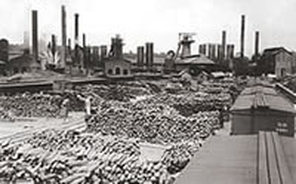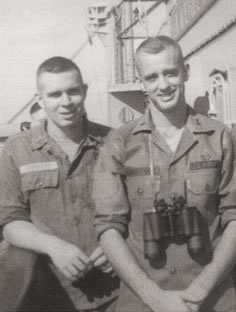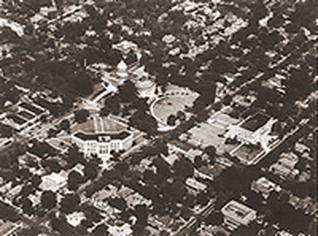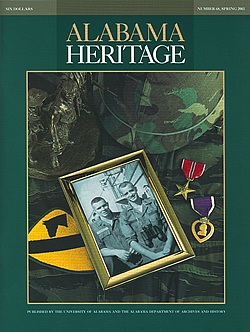|
On the cover: Ia Drang survivor, Jim Lawrence, treasures this photo with best friend Don Cornett above all other Vietnam mementos. (Photograph by Robin McDonald)
|
FEATURE ABSTRACTS
 (Historic American Buildings Survey,
(Historic American Buildings Survey,Prints and Photographs Division, Library of Congress)
The Making and Unmaking of The Woodward Iron Company
By Michael W. Fazio
Today, from the interstate in Birmingham you can still see remains of the Woodward Iron Company, which was founded in 1881 and didn't cease production until 1973. Michael Fazio tells the story of the Woodward family who created the company that would be called the "most vertically integrated ironmaking system on Earth." The Woodward Iron Company was founded by Stimpson Harvey Woodward, an ironmaker from Massachusetts, and its dynasty was born in 1882 when the first mine was opened on Red Mountain. A virtual boomtown followed: miles of railroad track, four locomotives, fifty railroad cars, sixty-three single coke ovens, eighty double coke ovens, and housing for over a thousand employees, all of which later became the town of Woodward. Michael Fazio describes the rise of the Woodward Iron Company throughout the late nineteenth century and into the twentieth, a rise that contributed to a national iron industry that overtook England as the world's leading producer of the metal. The iron boom couldn't last forever, though, and as the company moved into the early 1900s, iron prices dropped, and everyone in the industry suffered. This included the Woodwards, who lost millions of dollars before the Great Depression. The story of the Woodward Iron Company is as much about the Woodward family and their struggles as it is about the rise and fall of the iron industry in Alabama.
By Michael W. Fazio
Today, from the interstate in Birmingham you can still see remains of the Woodward Iron Company, which was founded in 1881 and didn't cease production until 1973. Michael Fazio tells the story of the Woodward family who created the company that would be called the "most vertically integrated ironmaking system on Earth." The Woodward Iron Company was founded by Stimpson Harvey Woodward, an ironmaker from Massachusetts, and its dynasty was born in 1882 when the first mine was opened on Red Mountain. A virtual boomtown followed: miles of railroad track, four locomotives, fifty railroad cars, sixty-three single coke ovens, eighty double coke ovens, and housing for over a thousand employees, all of which later became the town of Woodward. Michael Fazio describes the rise of the Woodward Iron Company throughout the late nineteenth century and into the twentieth, a rise that contributed to a national iron industry that overtook England as the world's leading producer of the metal. The iron boom couldn't last forever, though, and as the company moved into the early 1900s, iron prices dropped, and everyone in the industry suffered. This included the Woodwards, who lost millions of dollars before the Great Depression. The story of the Woodward Iron Company is as much about the Woodward family and their struggles as it is about the rise and fall of the iron industry in Alabama.
Additional Information
For information on other iron manufacturing in Birmingham, visit the website of Sloss Furnaces.
The following articles in the Encyclopedia of Alabama will also be of interest:
About the Author
Dr. Michael Fazio, A.I.A., is an architect and architectural historian. He holds a Bachelor of Architecture Degree from Auburn University, a Master of Architecture Degree from The Ohio State University, and a Ph.D. in the History of Architecture and Urban Development from Cornell University. He practices architecture in the southeast region, most often as a documentary and forensic architectural preservation consultant. he teaches architectural design studios and architectural history in the School of Architecture at Mississippi State University. his articles have appeared in the Society of Architectural Historians Journal, Arris (the journal of the Southeast Chapter of the Society of Architectural Historians), the Journal of Architectural Education, and the Journal of the White House Historical Society. His book Buildings Across Time: An Introduction to Architectural History (with co-authors Marian Moffett and Lawrence Wodehouse) will be published in 2003 by McGraw-Hill and his book Inventing the American House: The Domestic Architecture of Benjamin Henry Latrobe (with co-author Patrick Snadon) will be published in 2004 by The Johns Hopkins University Press. He is currently preparing a manuscript for a book on the architecture of Birmingham, Alabama, to be published by The University of Tennessee Press.
For information on other iron manufacturing in Birmingham, visit the website of Sloss Furnaces.
The following articles in the Encyclopedia of Alabama will also be of interest:
- Birmingham Iron and Steel Companies
- Iron and Steel Production in Birmingham
- Mining Labor
- Organized Labor in Alabama
About the Author
Dr. Michael Fazio, A.I.A., is an architect and architectural historian. He holds a Bachelor of Architecture Degree from Auburn University, a Master of Architecture Degree from The Ohio State University, and a Ph.D. in the History of Architecture and Urban Development from Cornell University. He practices architecture in the southeast region, most often as a documentary and forensic architectural preservation consultant. he teaches architectural design studios and architectural history in the School of Architecture at Mississippi State University. his articles have appeared in the Society of Architectural Historians Journal, Arris (the journal of the Southeast Chapter of the Society of Architectural Historians), the Journal of Architectural Education, and the Journal of the White House Historical Society. His book Buildings Across Time: An Introduction to Architectural History (with co-authors Marian Moffett and Lawrence Wodehouse) will be published in 2003 by McGraw-Hill and his book Inventing the American House: The Domestic Architecture of Benjamin Henry Latrobe (with co-author Patrick Snadon) will be published in 2004 by The Johns Hopkins University Press. He is currently preparing a manuscript for a book on the architecture of Birmingham, Alabama, to be published by The University of Tennessee Press.
 Jim Lawrence and Don Cornett
Jim Lawrence and Don Cornett(Jim Lawrence)
The Lost Battalion of the Ia Drang
By Philip D. Beidler
Mel Gibson was praised for his performance as U.S. Army Lieutenant General Harold Moore in last year's blockbuster We Were Soldiers, based on Hal Moore's book We Were Soldiers Once…and Young. In it, Moore describes the first vicious, but victorious, days of fighting in the Ia Drang valley of Vietnam. Philip Beidler's article picks up where the movie left off, telling the story of a tragic, terrifying ambush--a story that would never be fit for the silver screen. At the center of the horror of the battle was a twenty-four-year-old lieutenant from Troy, Alabama, named Jim Lawrence. Phil Beidler tells Jim's first-person account of what it was like to be in the middle of an enemy ambush. Jim Lawrence survived being shot point blank in the head and left for dead. He was rescued, and after he recovered from this injury, he went back to Vietnam to finish out his term in the army. Lawrence's story is one of personal victory set in the larger context of the victory of an outnumbered group of young soldiers who refused defeat in their first experience with combat.
By Philip D. Beidler
Mel Gibson was praised for his performance as U.S. Army Lieutenant General Harold Moore in last year's blockbuster We Were Soldiers, based on Hal Moore's book We Were Soldiers Once…and Young. In it, Moore describes the first vicious, but victorious, days of fighting in the Ia Drang valley of Vietnam. Philip Beidler's article picks up where the movie left off, telling the story of a tragic, terrifying ambush--a story that would never be fit for the silver screen. At the center of the horror of the battle was a twenty-four-year-old lieutenant from Troy, Alabama, named Jim Lawrence. Phil Beidler tells Jim's first-person account of what it was like to be in the middle of an enemy ambush. Jim Lawrence survived being shot point blank in the head and left for dead. He was rescued, and after he recovered from this injury, he went back to Vietnam to finish out his term in the army. Lawrence's story is one of personal victory set in the larger context of the victory of an outnumbered group of young soldiers who refused defeat in their first experience with combat.
Additional Information
The standard account of the Ia Drang Battles of X-Ray and Albany, as well as one of the great books to address the experience of the American war in Vietnam, is Harold G. Moore and Joseph L. Galloway, We Were Soldiers Once...and Young (Random House, 1992). It served as the basis of the film We Were Soldiers (Paramount, 2002).
Works from other perspectives include:
About the Author
Phil Beidler is Professor of English at the University of Alabama. He is a Vietnam veteran and recently won a Pushcart Prize for his writing about the Vietnam war.
Jim Lawrence is a managing partner of Lawrence Arrendell Humphries, a real estate firm in Birmingham. He is the author of Reflections on Lz Albany: The Agony of Vietnam. If you are interested in more information about his book, feel free to contact Jim via e-mail.
The standard account of the Ia Drang Battles of X-Ray and Albany, as well as one of the great books to address the experience of the American war in Vietnam, is Harold G. Moore and Joseph L. Galloway, We Were Soldiers Once...and Young (Random House, 1992). It served as the basis of the film We Were Soldiers (Paramount, 2002).
Works from other perspectives include:
- Coleman, J.D. Pleiku: The Dawn of Helicopter Warfare in Vietnam (St. Martin's Press, 1988)--a groundbreaking analysis of airmobile operations.
- Gwin, Larry. Baptism: A Vietnam Memoir (Ivy Books, 1999)--a personal narrative by an Ia Drang participant.
- Stewart, James B. Heart of a Soldier (Simon and Schuster, 2002)--the story of Rick Rescorla, an Ia Drang survivor killed in the 11 September 2001 terrorist destruction of the World Trade Center.
About the Author
Phil Beidler is Professor of English at the University of Alabama. He is a Vietnam veteran and recently won a Pushcart Prize for his writing about the Vietnam war.
Jim Lawrence is a managing partner of Lawrence Arrendell Humphries, a real estate firm in Birmingham. He is the author of Reflections on Lz Albany: The Agony of Vietnam. If you are interested in more information about his book, feel free to contact Jim via e-mail.
 Alabama's capitol complex, c. 1947
Alabama's capitol complex, c. 1947(Alabama Department of Archives and History)
Great and Illustrious Work: The 1930 Olmsted Plan for the Alabama Capitol
By Mary Walton Upchurch
In the 1930s Alabama's capitol underwent a transformation. As Governor Bibb Graves completed his final term in office, he could watch with satisfaction the changes he had brought to the state capitol. Once just a building, Alabama's capitol was becoming a stately urban center. Governor Bibb had sought out the Olmsted Brothers—whose famous father had designed Central Park in New York City and the "Emerald Necklace" of parks in Boston—to design a plan for the new capitol. Mary Walton Upchurch walks through various aspects of the Olmsted Plan and points out its unique and creative design for the capitol. Although the Olmsted Plan wasn't used in its entirety, the influence of this famous landscape architecture firm can be seen in several of the buildings and in the beautiful grounds that surround Capitol Hill.
By Mary Walton Upchurch
In the 1930s Alabama's capitol underwent a transformation. As Governor Bibb Graves completed his final term in office, he could watch with satisfaction the changes he had brought to the state capitol. Once just a building, Alabama's capitol was becoming a stately urban center. Governor Bibb had sought out the Olmsted Brothers—whose famous father had designed Central Park in New York City and the "Emerald Necklace" of parks in Boston—to design a plan for the new capitol. Mary Walton Upchurch walks through various aspects of the Olmsted Plan and points out its unique and creative design for the capitol. Although the Olmsted Plan wasn't used in its entirety, the influence of this famous landscape architecture firm can be seen in several of the buildings and in the beautiful grounds that surround Capitol Hill.
Additional Information
Multimedia:
About the Author
Mary Walton Upchurch is a registered landscape architect living in Montgomery. She graduated from the Harvard Graduate School of Design where she won the Webel Prize for design excellence in landscape architecture.
- Blair, Algernon. "State Capitol of Alabama, A paper read before The Thirteen." May 13, 1943.
- Hole, Donna Crim. "The Alabama State Capitol in Montgomery: An Architectural and Political History." A thesis submitted to the graduate faculty of Auburn University, March 16, 1979.
- Newton, Norman T. Design on the Land. (Belknap Press of Harvard University Press, 1971).
- "The Olmsted Papers, the correspondence files of the Olmsted Brothers, Landscape Architects on the Capitol Complex from 1927-1945." National Park Service, Frederick Law Olmsted National Historic Site.
Multimedia:
About the Author
Mary Walton Upchurch is a registered landscape architect living in Montgomery. She graduated from the Harvard Graduate School of Design where she won the Webel Prize for design excellence in landscape architecture.
DEPARTMENt ABSTRACTS
Art in the South
For Purple and Gold: College Night at the University of Montevallo
By Cynthia Shackelford
As University of Montevallo alumni from all over the country convergeon the campus each February for Homecoming, they come neither for gridiron heroics nor for tailgate parties; they come for the show--two original, student-produced, musical theater productions--and an internecine rivalry without peer.
Additional Information
The following article in the Encyclopedia of Alabama will also be of interest:
Multimedia:
Cynthia Shackelford is the director of public relations at the University of Montevallo and editor of Montevallo Today.
For Purple and Gold: College Night at the University of Montevallo
By Cynthia Shackelford
As University of Montevallo alumni from all over the country convergeon the campus each February for Homecoming, they come neither for gridiron heroics nor for tailgate parties; they come for the show--two original, student-produced, musical theater productions--and an internecine rivalry without peer.
Additional Information
The following article in the Encyclopedia of Alabama will also be of interest:
Multimedia:
- Alabama College to University of Montevallo
- Jeter Hall
- Reynolds Hall
- Typing Class, Alabama Girls’ Industrial School
- University of Montevallo
Cynthia Shackelford is the director of public relations at the University of Montevallo and editor of Montevallo Today.
Recollections
Mildred Carter: Tuskegee Airwoman
By Michael Sznajderman
Mildred Carter learned to fly alongside many of the famous Tuskegee Airmen as a member of the short-lived Civilian Pilot Training Program, an initiative designed to train undergraduates to become civilian pilots on the eve of World War II. She earned her pilot's license mere months before women were banned from the CPTP in the face of the oncoming war. Though the race- and gender-based discrimination prevented Mildred from using her pilot's skills on behalf of the war effort, aviation would always be central to Mildred's life, and--together with her husband, Herbert Carter--she is often honored at events honoring the Tuskegee Airmen.
Additional Information
The following article in the Encyclopedia of Alabama will also be of interest:Multimedia:
About the Author
Michael Sznajderman is a former newspaperman and part-time freelance writer. He works full-time in corporate communications.
Mildred Carter: Tuskegee Airwoman
By Michael Sznajderman
Mildred Carter learned to fly alongside many of the famous Tuskegee Airmen as a member of the short-lived Civilian Pilot Training Program, an initiative designed to train undergraduates to become civilian pilots on the eve of World War II. She earned her pilot's license mere months before women were banned from the CPTP in the face of the oncoming war. Though the race- and gender-based discrimination prevented Mildred from using her pilot's skills on behalf of the war effort, aviation would always be central to Mildred's life, and--together with her husband, Herbert Carter--she is often honored at events honoring the Tuskegee Airmen.
Additional Information
The following article in the Encyclopedia of Alabama will also be of interest:Multimedia:
About the Author
Michael Sznajderman is a former newspaperman and part-time freelance writer. He works full-time in corporate communications.
 The Helicopsyche
The Helicopsyche Actual size: 1/8 inch
(W. Mike Howell)
Nature Journal
Helicopsyche
By L. J. Davenport
The Helicopsyche is a snail-mimicking, caddisfly larva; it performs a variety of vital functions in the rivers and streams of Alabama--grazing on submerged rocks and logs, catching and shredding decomposing leaves, piercing plant stems to sup their sap, and preying on smaller creatures. L.J. Davenport discusses the Helicopsyche life-cycle, as well as inquiring into the nature and purpose of its shell.
Additional Information
The following article in the Encyclopedia of Alabama will also be of interest:
About the Author
Larry Davenport is a professor of biology at Samford University, Birmingham, Alabama.
Helicopsyche
By L. J. Davenport
The Helicopsyche is a snail-mimicking, caddisfly larva; it performs a variety of vital functions in the rivers and streams of Alabama--grazing on submerged rocks and logs, catching and shredding decomposing leaves, piercing plant stems to sup their sap, and preying on smaller creatures. L.J. Davenport discusses the Helicopsyche life-cycle, as well as inquiring into the nature and purpose of its shell.
Additional Information
The following article in the Encyclopedia of Alabama will also be of interest:
About the Author
Larry Davenport is a professor of biology at Samford University, Birmingham, Alabama.
